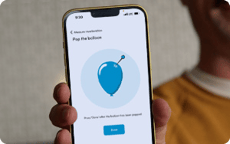What is HyFlex teaching and learning — and how to set up for success

Posted by Tricia Whenham on Aug 4, 2021 6:00:00 AM
When US postsecondary students were surveyed about their hopes for post-pandemic education, the results were surprising.
Despite the incredibly fast pivot to online and hybrid learning that COVID-19 made necessary, and all the challenges that resulted, 68% of students agreed that they would like to take courses in the future that offered a combination of in-person and online instruction. It’s this kind of reaction that’s causing an increasing number of colleges and universities to take a closer look at HyFlex teaching and learning.
What is HyFlex?
In a typical HyFlex course, instruction is offered in person and online — at the same time. Students may opt to head to the classroom for their session. Or they can join remotely, logging in from their home or dorm room. It’s up to them. Either way, they receive the same high-quality learning experience — just from different places.
Often, HyFlex courses also add an asynchronous component, allowing students who can’t attend either in person or virtually to view a lecture recording after the fact. But watching a recording isn’t at the heart of this educational approach. During each class, HyFlex aims to make remote learning just as interactive and engaging as in-person learning.
With HyFlex, flexibility isn’t the by-product — it’s the entire point. By allowing students to choose between face-to-face or remote instruction on a weekly or even daily basis, and by prioritizing active learning for both audiences, HyFlex strives to ensure that flexibility doesn’t come at a cost. And another bonus — with HyFlex, it’s not just students who have more options. Instructors can also teach remotely if the situation calls for it.
HyFlex has been here since around 2006, when Brian J. Beatty and others conceived the idea. And though it played a key role in keeping students safe during the pandemic, HyFlex will enable institutions to keep meeting student needs when COVID-19 is a distant memory.

How it can help your college or university
HyFlex isn’t without its challenges. But if executed well, it provides an exceptional learning experience for a wider variety of students. Here’s how it can help your college or university.
1. Meeting individual student needs
Students’ experience with remote learning has not been one-size-fits-all. While some never want to learn online again, others have thrived outside the physical classroom. HyFlex courses offer more options for success, especially for neurodiverse students or those juggling the demands of family or jobs. Letting students choose the way they participate in classes makes them much more likely to do so.
2. Adapting to challenging circumstances
Even for students who prefer learning face-to-face, sometimes life gets in the way. With HyFlex, off-campus students can be spared a long commute through bad traffic, and snow days don’t require them to make the trek to school on dangerous roads. Plus, disruptions like medical appointments can be managed more easily if students have the option to log in to class from anywhere.
3. Enabling travel for professors
Though HyFlex is often talked about in terms of student need, extra flexibility can be a lifesaver for instructors as well. Some travel frequently and want to avoid canceling class when on the road. Others need to manage research trips or academic conferences. Delivering instruction remotely isn’t always the answer, but HyFlex makes it a viable option.
4. Reducing the spread of illness
Do your students ever attend class sick? Being in the classroom with a cough or cold, even if it's mild, is far from ideal. With HyFlex, students don’t have to miss out when they’re too sick to come to class but not too sick to learn. It’s easy to join remotely and avoid passing germs around. And this goes for professors as well.
5. Preparing for the hybrid workforce
When students graduate, many will be heading into a world where hybrid work is the norm. According to a Future Forum survey of knowledge workers, 76% want flexibility in where they work. HyFlex courses at college or university help prepare students to thrive in the new hybrid workforce. They’ll learn how to collaborate effectively during hybrid meetings plus develop a variety of asynchronous communication skills.

What instructors need most
What’s the downside of the HyFlex model? It can be hard to do well. Teaching to two audiences at once — in person and remote — is no easy feat. Here are a few crucial things that can help get your instructors on board quickly.
Easy audio and video conferencing tools
If instructors must spend their time worrying about the technology in the room, they’ll never be able to focus on what matters most. Make sure your UC&C, audio conferencing and video conferencing solutions place a premium on simplicity. When it comes to your essential HyFlex tools, adding layers of complexity is simply no longer sustainable.
Lecture capture solutions
Giving students the option to watch course content asynchronously is another way that HyFlex courses offer flexibility. So you’ll need a lecture capture solution — either a full system that works well with the rest of the technology in your room or a DIY setup that relies on your UC&C client to record sessions.
Professional development
HyFlex is new, so most instructors will need extra support. That includes both professional development in the HyFlex educational approach and ample time to get familiar with all the products in the room. Having IT support on standby is also essential so that technical issues don’t derail the class. And because getting remote students to participate can be a huge initial barrier, here are 21 activities to get everyone talking.
What students need most
HyFlex has a learning curve for students as well. Here are a few things you can add to your classrooms that will have an impact.
Reliable full-room audio
Unlike some postsecondary approaches, HyFlex requires active participation from students — no matter where they are. If students can’t hear each other, this is next to impossible. And if instructors need to continually repeat student questions and comments, it slows down everything. Make sure that your audio solution picks up student voices throughout the entire classroom, without requiring you to stop and share a handheld mic. Here’s how Nureva® audio fits the bill.
An active backchannel
A backchannel gives students a way to participate in class without always having to raise their hand to speak. Some institutions create a dedicated class message board, while others take advantage of the chat feature already in your UC&C application. It helps to assign a student or TA to monitor the backchannel so instructors don’t need to divide their focus.
Breakout rooms
Breakout rooms are the secret to allowing small group work with in-person and remote students, and most UC&C platforms have them. If all your face-to-face students have laptops and headphones with mics, then you can pair up remote students with those in class, helping to keep everyone connected.
Need more ideas for what to include in your HyFlex classrooms? Here’s a list of 9 HyFlex essentials.
More HyFlex resources
Looking to see how other universities and colleges are implementing HyFlex in their classrooms? Check out these resources:
- Columbia University — watch video testimonials and see how you can assign student roles
- University of Florida — get checklists, sample learning activities and more
- University of San Diego — see how HyFlex classrooms are set up and get technical how-to guides
- Vanderbilt University — get a list of active learning activities for HyFlex or hybrid classrooms
And if you’re ready to take a deeper dive into the world of HyFlex, one of the key resources on the subject — Hybrid-Flexible Course Design by Brian J. Beatty — is available for free online.
Editor’s note: This post was originally published August 2021 and has been updated.

Posted by
Tricia Whenham
August 4, 2021


















